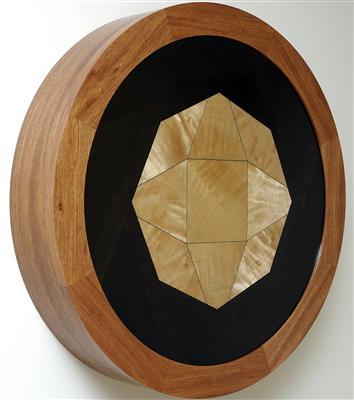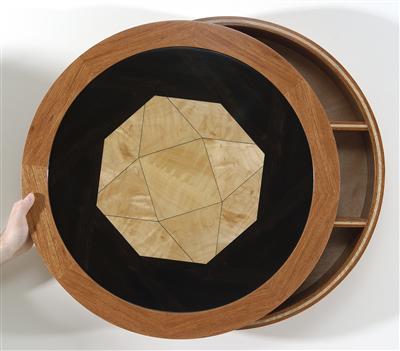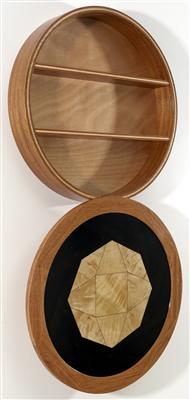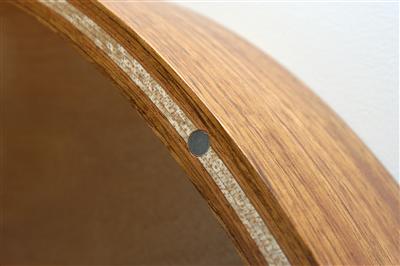|
|
|
|
|
|
|
# 77 |
|
Mark Nadeau |
|
Portsmouth, RI |
|
|
| Dimensions
(inches):
|
|
|
Width:
|
25 |
|
|
Height:
|
25 |
|
|
Depth:
|
4.75 |
| Materials:
|
Jatoba (Brazilian Cherry), Curly Maple, commercial Ebony veneer, and Lauan (Philippine Mahogany) plywood. |
|

As soon as I found out about this contest, I got to work on a design. It had been a while since I last worked on a woodworking project, so this was the perfect excuse. I have spent somewhere between 280 to 300 hours working on it since the beginning of April. It was completed for Father’s Day. I chose a technically difficult but visually simple design. I tried to make something that I thought had never been done before. It is a decorative cabinet made from Jatoba (Brazilian Cherry), Curly Maple, commercial Ebony veneer, and Lauan (Philippine Mahogany) plywood. The motif on the front panel was taken from a style of Buffard Freres banding called “FIFA,” which is pictured in an old 1996 Lee Valley Tools catalog. It is very much a quilting design, and was named “FIFA” because it resembles a soccer ball. I chose it because it is a geometric form that is spherical in nature. The Curly Maple is book-matched from one side to the other on the "FIFA" design. It was then edged with Ebony veneer, and surrounded in a field of Ebony, giving it a floating or suspended appearance.
|
| |

The carcass is a round bent wood lamination which hangs tight against the wall by means of a French Cleat. I chose not to use decorative edges, as anyone can rout a chamfer or a round over. Sharp clean edges are far more challenging to maintain, and I felt that it fit the “disk” design. The edges were of course eased with sandpaper to be easy on the hands and properly accept a finish. I loved the fact that it was a perfect disk, and I did not want to disrupt the form with a knob. Because of the way that the cabinet opens, I feel it was a good choice. If a knob were present, one’s natural reaction would be to pull on it. Without a knob, one is forced to grab the sides of the cabinet to discover how it opens. They then easily find that it rotates. Two visible rare earth magnets at the top hold the face closed in place. Two more hidden magnets at the bottom on either side of the pivot hinge, grab the face when it is in the open position and prevent it from swinging like a broken limb. The pivot hinge is a stainless steel bolt set into a SS threaded sleeve in the carcass. When the door is closed, the face is tight against the carcass. When opened (by turning to the left), the face is only a fraction of an inch away from the carcass, as the bolt is only turned ½ turn in the process. This also allows one to remove the face by unscrewing it if it ever needed a repair or refinish in the future. The finish procedure was as follows: Sanding to 220 grit, Sanding Sealer, Sanding to 320 grit, 2 coats of Semi-Gloss Polyurethane, Buffing with #0000 Steel Wool, and then Satin Finishing Wax. The face slides easily with minimal friction.
|
| |

Templates marked in quadrants were used to properly mark the carcass and face for the drilling required for the magnets and pivot hinge. This was a one shot deal, as the face was NOT flush trimmed to the carcass. The face was made so that there is approximately a 1/64” overlap all the way around, making proper alignment paramount. These same templates were also used to make the shelves parallel with each other and perpendicular to the centerline of the cabinet.
|
| |

The routing template for the face frame and the bending form for the carcass were fabricated from MDF. I cut the Jatoba and Maple veneers myself. It was glued/bent/clamped 2 layers at a time with the exception of the 3 Curly Maple layers which were all done at once. This was a very time consuming process. The layers had to be marked so that proper alignment could be maintained. However, alignment could never be maintained perfectly since the layers begin to slip past one another as the bend of the circle is made. Each piece of veneer was mitered on one end, then bent around the form with clamps and marked for the cutting of the mating miter. This process was repeated over and over again until proper fit was accomplished before each glue-up, which was done entirely with slow setting epoxy. The lamination is just over 3/4” thick. The miter joints are located at the top of the cabinet and are staggered for strength. The shelves are 5/8” thick solid stock with an inlay in the face. They are set back from the carcass 1/8". The Lauan back had just the right grain and color, giving just a little bit of contrast.
|
| |

We needed something for the West wall of the family room. This did very nicely, as it is a functional piece of art. It will most likely be used to hold candles, matches, and a flashlight since we frequently loose power here in a storm. When that happens, we are usually in the family room and have to scurry about the house in the dark to find a light source… no more.
|
| |
|
|